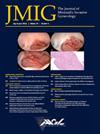Association of Body Mass Index With Surgical Complications After Laparoscopic Hysterectomy
IF 3.5
2区 医学
Q1 OBSTETRICS & GYNECOLOGY
引用次数: 0
Abstract
Study Objective
To study the association between BMI and short-term postoperative complications of patients undergoing minimally invasive (MIS) hysterectomy.
Design
A cohort study of prospectively collected data.
Setting
American College of Surgeons National Surgical Quality Improvement Program (NSQIP) database from 2012 – 2020.
Patients or Participants
Patients requiring MIS hysterectomy for benign conditions.
Interventions
MIS hysterectomy.
Measurements and Main Results
We categorized patients who had undergone MIS hysterectomy into body mass index (BMI) subgroups according to World Health Organization classification and compared rates of 30-day postoperative major and minor complications, defined according to the Clavien-Dindo classification, across BMI groups.
A total of 206,944 patients met the inclusion criteria. In multivariable regression analysis, when comparing those with low and high BMI there was a statistically significant increase in any complications [aOR 95%CI 1.06(1.01-1.10)] and minor complications [aOR 95%CI 1.13(1.07-1.19)] in the high BMI group but no differences in major complications across the two groups [aOR 95%CI 0.96(0.88-1.04)].
When comparing classes of obesity to the normal BMI group, Class I, II, and III categories had a lower likelihood of major complications [aOR 95%CI 0.87(0.80-0.93), 0.84(0.77-0.91), 0.82(0.75-0.90), and 0.83(0.75-0.91), respectively] when compared to normal weight individuals. However, patients in the Class II and III categories had a higher likelihood of minor complications [aOR 95%CI 1.12(1.03-1.21), and 1.17(1.08-1.28), respectively] when compared to normal weight individuals.
The mean operative time was significantly longer for each BMI group compared to lower BMI groups (range 115.2-144.5 minutes, p<0.05).
Conclusion
Higher BMI was associated with a higher risk of all complications and minor complications than low BMI in patients undergoing MIS hysterectomy, as well as increased operative time. However, when comparing across specific BMI categories, overweight and obesity categories were associated with lower risks of major complications compared to the normal BMI category. These findings can help in preoperative patient counseling.
体重指数与腹腔镜子宫切除术后手术并发症的关系
研究目的研究接受微创(MIS)子宫切除术的患者的体重指数与术后短期并发症之间的关系.设计对前瞻性收集的数据进行队列研究.设置美国外科学院国家外科质量改进计划(NSQIP)数据库(2012-2020年).患者或参与者因良性疾病需要接受MIS子宫切除术的患者.干预措施MIS子宫切除术.测量和主要结果我们根据世界卫生组织的分类将接受MIS子宫切除术的患者分为体重指数(BMI)亚组,并比较了不同BMI组的术后30天主要和次要并发症发生率(根据Clavien-Dindo分类法定义).共有206944名患者符合纳入标准.在多变量回归分析中,当比较低体重指数组和高体重指数组时,高体重指数组的任何并发症[aOR 95%CI 1.06(1.01-1.10)]和轻微并发症[aOR 95%CI 1.13(1.07-1.19)]显著增加,但两组的主要并发症没有差异[aOR 95%CI 0.将肥胖等级与正常体重指数组进行比较时,与正常体重者相比,I、II和III级肥胖者发生主要并发症的可能性较低[aOR 95%CI 分别为0.87(0.80-0.93)、0.84(0.77-0.91)、0.82(0.75-0.90)和0.83(0.75-0.91)]。然而,与正常体重者相比,II 级和 III 级患者发生轻微并发症的可能性更高[aOR 95%CI 分别为 1.12(1.03-1.21)和 1.17(1.08-1.28)]。与较低体重指数组相比,各体重指数组的平均手术时间明显更长(范围为 115.结论在接受 MIS 子宫切除术的患者中,较高的体重指数与较低的体重指数相比,所有并发症和轻微并发症的风险更高,手术时间也更长。然而,在对特定体重指数类别进行比较时,超重和肥胖类别与正常体重指数类别相比,主要并发症的风险较低。这些发现有助于对患者进行术前咨询。
本文章由计算机程序翻译,如有差异,请以英文原文为准。
求助全文
约1分钟内获得全文
求助全文
来源期刊
CiteScore
5.00
自引率
7.30%
发文量
272
审稿时长
37 days
期刊介绍:
The Journal of Minimally Invasive Gynecology, formerly titled The Journal of the American Association of Gynecologic Laparoscopists, is an international clinical forum for the exchange and dissemination of ideas, findings and techniques relevant to gynecologic endoscopy and other minimally invasive procedures. The Journal, which presents research, clinical opinions and case reports from the brightest minds in gynecologic surgery, is an authoritative source informing practicing physicians of the latest, cutting-edge developments occurring in this emerging field.

 求助内容:
求助内容: 应助结果提醒方式:
应助结果提醒方式:


